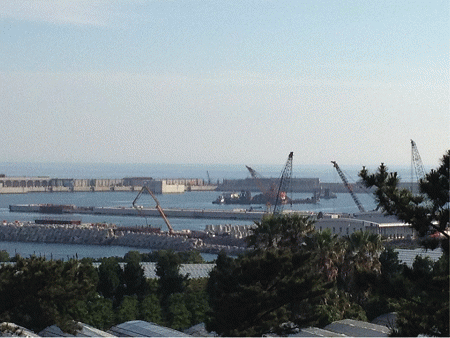When I returned in 2013, despite the intense efforts of the activists, the Guremobi rock formation had been blown up with dynamic and construction had begun with two huge facilities built on the remains of the rocks to create the massive concrete caissons that would be lowered into the ocean to form the quarter mile long breakwater to protect the base from the open ocean.
Returning two years later in 2015 with eight women from the Women Cross the DMZ walk www.womencrossdmz, including Nobel Peace laureate Mairead Maguire and CODEPINK co-founder Medea Benjamin, I was devastated to see the vastness of the naval base which is nearing completion. Although statistics on the amount of concrete that has been poured into the ocean and into the buildings on the base are unavailable, the sheer scale of the base leads one to guess that a road around the world could have been built with that volume of concrete.
And it's not just on the base itself that construction has proceeded. As villagers suspected from the beginning, the base would expand into other parts of the community. More land near the base is now being condemned by the government so it can be used to build housing for military personnel and their families.
After seven years of large protests against the construction of the military base, the base has been built -- and the Chinese know it as they have watched the construction -- up close -- as, remarkably, the South Korean government allows Chinese tourists to visit Jeju Island without a visa. The Chinese tourist trade is large -- as is the purchase of land by Chinese on Jeju Island. A big area on Jeju Island is now a Chinese "health" vacation area with condos and other facilities for Chinese -- even the road signs in the area are in Chinese!
The Chinese are watching another construction project in the Pacific. This time a United States military base on the southern Japanese island of Okinawa. Despite massive Okinawan opposition, including a visit in May 2015 of the governor of Okinawa to Washington, DC, the U.S. is planning to begin expansion of Camp Schwab, a U.S. Marine Corps base and construction of an airfield runway on Okinawa. The runway will project out into the South China Sea into pristine waters with endangered coral formations and into the habitat of the dugong, a manatee-like marine mammal. Okinawa makes up 1% of Japan's land mass but is the location of 74% of all U.S. military bases in Japan.
Okinawans have been protesting for years the expansion of Camp Schwab, a U.S. Marine Base. Only last month, over 35,000 Okinawans gathered to voice their opposition to their national government's approval of the base despite the opposition of all levels of the Okinawan provincial government and island civil society.
In 2007, I visited the activists on Okinawa at their seaside camp where they have a daily presence to remind the U.S. military that they do not want the naval base. The senior citizens of the village of Henoko moved their Senior Citizens center to the beach so they could participate each day in attempting to preserve their village from another military base. (RT footage)
The Chinese have been watching the process for the building of another U.S. base in the Pacific, as they have watched the expansion of U.S. military forces on the U.S. territory of Guam. The projected increase in U.S. military personnel and their families is expected to increase the population of the small Micronesian island by 30 percent.
In another interesting economic considerations versus foreign policy posturing between sparing countries, Russian tourists to Guam do not need a visa to the United States to visit the island.
The bottom line is that the Chinese see the expansion of the United States military forces and capabilities in their front yard and are constructing their own projections of power on the tiny disputed islands and atolls off their coast. Neither the United States nor China need any of these bases as both have more than enough air capability in the form of aircraft or missiles to initiate or counter any military move by the other.
All of this construction is another example of the never ending, massively expensive war mindset of political leaders and their financial backers who profit from a hostile world.
(Note: You can view every article as one long page if you sign up as an Advocate Member, or higher).







